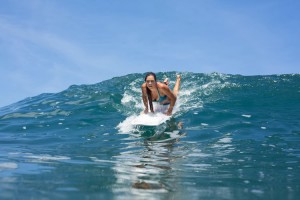Catching waves on the short board is a big step from catching foam waves. It requires better positioning, timing, and more courage. It also requires that as a beginner, surfers mastered the correct pop up posture on the board.

The Correct Pop Up Posture
The correct pop up posture is an issue that has many intermediates coming back for a surf lesson. 95% of them have the same issue. They have gotten into the habit of letting one shoulder drop back and their hips and buttocks are hanging over one rail. They fall over that rail.
The posture for new people has to be with the front foot in the middle of the board with preferably a 45 degree angle across the stringer. The shoulders and hips have to be squared to the front so that weight is equal on both sides of the stringer running up the middle of the board.
Positioning
Positioning to catch a real wave is important. Other surfers in the line up are a good indication of the best place to catch incoming waves. Factor in what type of board they are riding in that long boards can catch waves earlier than short boards.
Timing
The timing is a factor more important than on foam waves. The wave has to roll under the surf board and when the wave is over head and the board is pointing down, the surfer gives three hard paddles to move down the wave. Many surfers then point the board toward the pocket before popping up.
Courage
Courage has to be greater than catching foam waves. If the timing is not correct, the wave can crash on top of the surfer or the surfer misses the wave. The surfer has to be in front of the wave and not try to paddle over the top as it passes.
Watching other surfers and video is a great way to progress. The more you practice, the more you notice about what other surfers are doing. Catching waves is something surfers practice all their lives and is the most daring aspect of the sport.
For Surf Lessons in Oceanside, see the Home Page
A good video on Catching Green Waves.